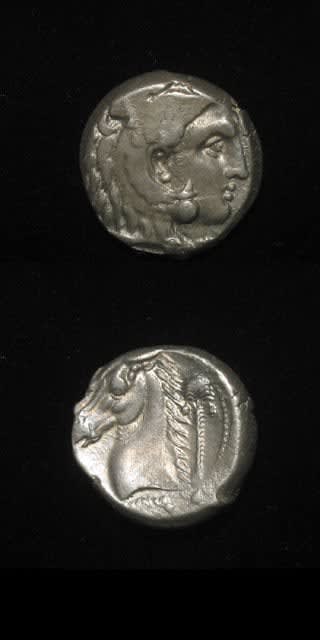Siculo-Punic Silver Tetradrachm, 320 BCE - 300 BCE
Silver
C.7670
Further images
Obverse: Head of Melqart/Herakles Facing Right, Wearing Lion Skin Headdres Reverse: Horse Head Facing Left, Palm Tree to the Righ The legendary city of Carthage was founded on the shores...
Obverse: Head of Melqart/Herakles Facing Right, Wearing Lion Skin Headdres
Reverse: Horse Head Facing Left, Palm Tree to the Righ
The legendary city of Carthage was founded on the shores of what is today the nation of Tunisia by Phoenicians colonists from Tyre. From these humble beginnings, Carthage rose to become the dominant mercantile and naval power of the Western Mediterranean, expanding from their base in North Africa to the coast of southern Spain, the Balearic Islands, Sardinia, Corsica, and Sicily. With a relatively small population of Phoenician ancestry, Carthage heavily relied upon mercenaries to fight their war that inevitably erupted as their influence grew. As Carthaginian settlements in western Sicily began to spread eastwards, they encountered the Greek cities on the island, resulting in intermittent wars as the Greeks and Carthaginians battled for control of the strategic island. Initially, Carthage allied themselves with the burgeoning power of Rome, who sought to limit the Greek presence in Southern Italy. Eventually, Rome and Carthage became bitter rivals, engaging in a series of battles known as the Punic Wars that culminated in the complete destruction of Carthage in 146 B.C.
Carthaginian coinage was first minted at the end of the 5th century B.C., most likely in order to pay their mercenary forces. As such, it is believed that the coins were minted in Sicily and directly distributed to the soldiers. While the earliest coinage imitates the style of those minted by the Greek cities of Sicily, namely Syracuse, as Carthaginian coinage developed over the centuries it began to exhibit a uniquely Punic style. Typical features found on Carthaginian coinage include the head of the Goddess Tanit, a horse, and a palm tree. In the mid to late 4th century B.C., Carthaginian authorities minted a series of Attic-weight tetradrachms, likely to pay mercenaries. The last type of this series were based on the coinage of Alexander the Great, depicting the head of Herakles on the obverse, whom the Carthaginians identified with their deity Melqart. The reverse showed the head of a horse and a palm tree along with legends reading either “MMHNT” (meaning “people of the camp”) or “MHSBM” (meaning “the Quaestors”). The first legend suggests the coins were not minted in a specific location, but rather in moving mints that followed the army. The second legend likely refers to at least two different military authorities responsible for the coinage.
Reverse: Horse Head Facing Left, Palm Tree to the Righ
The legendary city of Carthage was founded on the shores of what is today the nation of Tunisia by Phoenicians colonists from Tyre. From these humble beginnings, Carthage rose to become the dominant mercantile and naval power of the Western Mediterranean, expanding from their base in North Africa to the coast of southern Spain, the Balearic Islands, Sardinia, Corsica, and Sicily. With a relatively small population of Phoenician ancestry, Carthage heavily relied upon mercenaries to fight their war that inevitably erupted as their influence grew. As Carthaginian settlements in western Sicily began to spread eastwards, they encountered the Greek cities on the island, resulting in intermittent wars as the Greeks and Carthaginians battled for control of the strategic island. Initially, Carthage allied themselves with the burgeoning power of Rome, who sought to limit the Greek presence in Southern Italy. Eventually, Rome and Carthage became bitter rivals, engaging in a series of battles known as the Punic Wars that culminated in the complete destruction of Carthage in 146 B.C.
Carthaginian coinage was first minted at the end of the 5th century B.C., most likely in order to pay their mercenary forces. As such, it is believed that the coins were minted in Sicily and directly distributed to the soldiers. While the earliest coinage imitates the style of those minted by the Greek cities of Sicily, namely Syracuse, as Carthaginian coinage developed over the centuries it began to exhibit a uniquely Punic style. Typical features found on Carthaginian coinage include the head of the Goddess Tanit, a horse, and a palm tree. In the mid to late 4th century B.C., Carthaginian authorities minted a series of Attic-weight tetradrachms, likely to pay mercenaries. The last type of this series were based on the coinage of Alexander the Great, depicting the head of Herakles on the obverse, whom the Carthaginians identified with their deity Melqart. The reverse showed the head of a horse and a palm tree along with legends reading either “MMHNT” (meaning “people of the camp”) or “MHSBM” (meaning “the Quaestors”). The first legend suggests the coins were not minted in a specific location, but rather in moving mints that followed the army. The second legend likely refers to at least two different military authorities responsible for the coinage.
2
of
2





